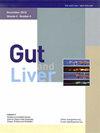Epidemiology of Disorders of the Gut-Brain Interaction: An Appraisal of the Rome IV Criteria and Beyond.
IF 3.4
3区 医学
Q2 GASTROENTEROLOGY & HEPATOLOGY
引用次数: 0
Abstract
Disorders of the gut-brain interaction (DGBIs) are presently classified into mutually exclusive anatomical area-related symptom-based categories according to the Rome IV criteria. The pathophysiology of visceral nociception, which contributes to the wide range of symptoms of DGBIs, involves complex psychobiological processes arising from the bidirectional interactions of multiple systems at the gut and brain levels, which affect symptom expression and illness behaviors. The attitude toward an illness and expression of pain and bowel habit vary across cultures with variable interpretation based on sociocultural beliefs, which may not tally with the medical definitions. Thus, psychological factors impact DGBI definitions, their severity and health care utilization. Due to the poor localization and multisegment referral of visceral pain, the anatomical site of pain may not correspond to the affected segment, and there may be a variable degree of overlap among symptoms. The somewhat restrictively defined Rome IV criteria assume one-to-one correlation of symptoms with underlying pathophysiology and ignore overlapping DGBIs, nonstandardized symptom categories, and change or shift in category over time. The microorganic nature of DGBIs resulting from systemic, metabolic or motility disorders, gut dysbiosis and inflammation are not addressed in the Rome IV criteria. Although there is a multidimensional clinical profile that does address these factors, it is not followed rigorously in practice. Threshold changes for diagnostic criteria or addition/deletion of symptoms leads to wide variation among different DGBI criteria resulting in uncertain comparability of results. Although the Rome IV criteria are excellent for research studies and therapeutic trials in homogenous populations, further improvement is needed for their wider applicability in clinical practice.肠道-大脑相互作用紊乱的流行病学:罗马 IV 标准及其他标准的评估》。
目前,肠道-大脑相互作用疾病(DGBIs)根据罗马IV标准被划分为相互排斥的解剖区域相关症状类别。内脏痛觉的病理生理学导致了 DGBIs 的多种症状,其中涉及肠道和大脑多个系统双向互动产生的复杂心理生物学过程,这些过程影响了症状表达和疾病行为。不同文化背景的人对疾病的态度以及对疼痛和排便习惯的表达各不相同,基于社会文化信仰的解释也不尽相同,这可能与医学定义不一致。因此,心理因素会影响 DGBI 的定义、严重程度和医疗保健的使用。由于内脏疼痛的定位性差和多节段转归,疼痛的解剖部位可能与受影响的节段不一致,而且症状之间可能存在不同程度的重叠。罗马 IV 标准的定义略显狭隘,它假定症状与潜在病理生理学是一一对应的,而忽略了 DGBI 的重叠、非标准化症状类别以及随着时间推移类别的变化或转移。罗马 IV 标准没有涉及全身性、代谢性或运动性疾病、肠道菌群失调和炎症导致的 DGBI 的微生物性质。虽然有一个多维临床概况确实涉及到这些因素,但在实践中并未得到严格遵守。诊断标准阈值的变化或症状的增加/删除导致不同的 DGBI 标准之间差异很大,导致结果的可比性不确定。尽管罗马 IV 标准非常适合同质人群的研究和治疗试验,但仍需进一步改进才能更广泛地应用于临床实践。
本文章由计算机程序翻译,如有差异,请以英文原文为准。
求助全文
约1分钟内获得全文
求助全文
来源期刊

Gut and Liver
医学-胃肠肝病学
CiteScore
7.50
自引率
8.80%
发文量
119
审稿时长
6-12 weeks
期刊介绍:
Gut and Liver is an international journal of gastroenterology, focusing on the gastrointestinal tract, liver, biliary tree, pancreas, motility, and neurogastroenterology. Gut and Liver delivers up-to-date, authoritative papers on both clinical and research-based topics in gastroenterology. The Journal publishes original articles, case reports, brief communications, letters to the editor and invited review articles in the field of gastroenterology. The Journal is operated by internationally renowned editorial boards and designed to provide a global opportunity to promote academic developments in the field of gastroenterology and hepatology.
Gut and Liver is jointly owned and operated by 8 affiliated societies in the field of gastroenterology, namely: the Korean Society of Gastroenterology, the Korean Society of Gastrointestinal Endoscopy, the Korean Society of Neurogastroenterology and Motility, the Korean College of Helicobacter and Upper Gastrointestinal Research, the Korean Association for the Study of Intestinal Diseases, the Korean Association for the Study of the Liver, the Korean Pancreatobiliary Association, and the Korean Society of Gastrointestinal Cancer.
 求助内容:
求助内容: 应助结果提醒方式:
应助结果提醒方式:


